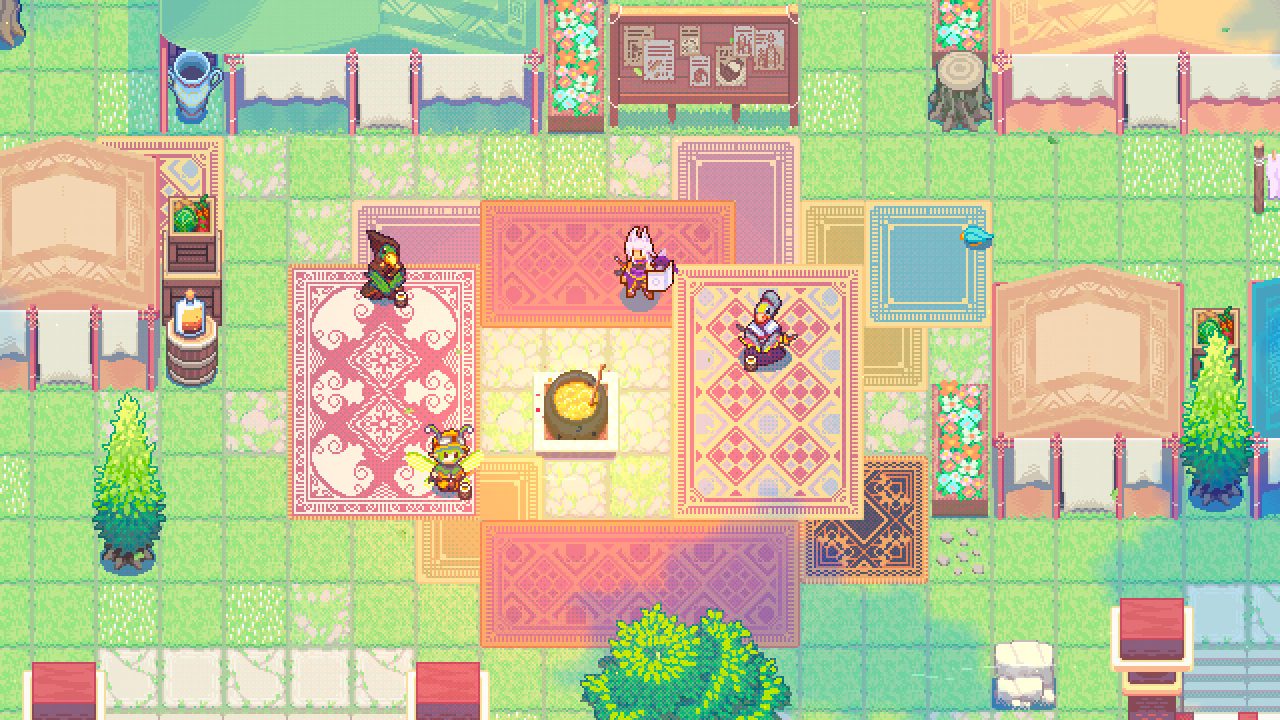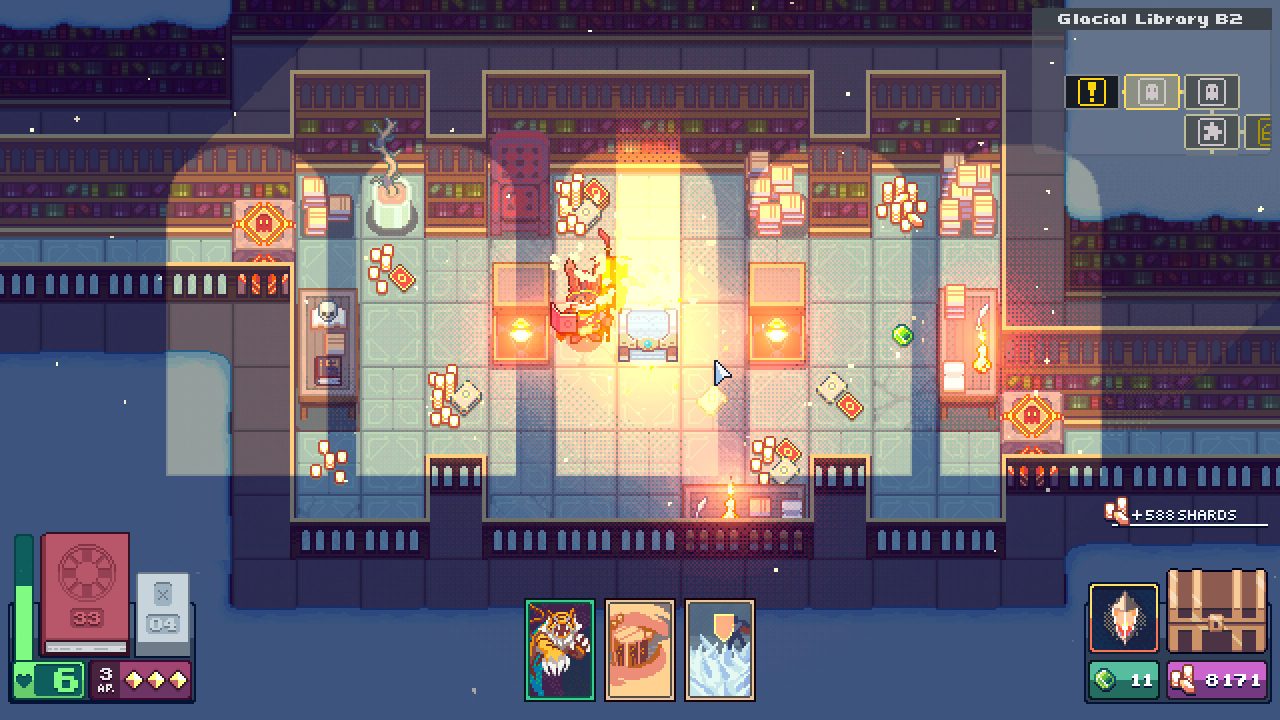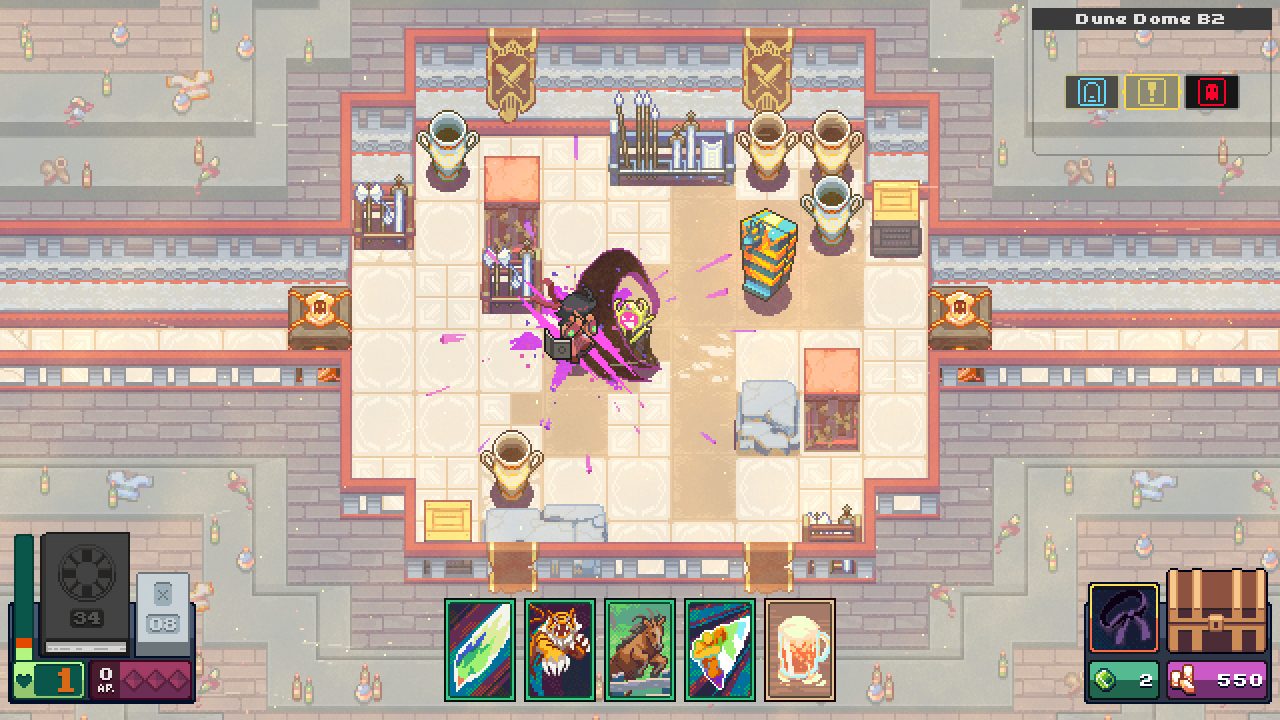A roguelike deck builder strategy RPG hybrid? It must be my birthday. My favorite genres all rolled up into one with a charming, colorful cartoon aesthetic and tile-based movement glory. Dungeon Drafters makes a powerful case for genre melding with its highly customizable gameplay, minigame variety, and unique field of combat design. With a staggering amount of cards that seem to encourage a wealth of decision making, what is there not to like? Plenty, unfortunately.
After choosing one of six characters who have starter decks geared towards a specific playstyle, players are treated to a brief cutscene demonstrating a shipwreck that lands the protagonist on an island. Now that they’re stranded, the character is free to hunt for cards in elemental dungeons to stop a looming evil from taking over the land. How altruistic. As is routine for games of this style, the story doesn’t matter all that much, but players have an intimidating number of villagers to talk to who rarely say anything different over the course of this 25- to 30-ish hour bedlam of forced strategy and RNG death.
Dungeon Drafters’ gameplay loop involves going into dungeons for a few floors and then fighting a boss. After beating the boss, the player can have more cards in their deck and equip stronger cards of their choosing. The deck determines what abilities players can use with their three action points per turn: it all depends on what they draw. Players have the option to leave the dungeon after traversing far enough as a means of saving the money and card packs they’ve accumulated. If players choose to leave, they have to start over from the beginning of the dungeon, but if they die, they lose everything and have to start over, anyway. Essentially, if players think they’re ready to topple the boss, they can sprint to the end, or they can grind in more thorough fashion in order to discover new cards and gain more money.

Combat takes place in bite-size rooms which players are locked into once they enter. Generally, the rooms are square- or rectangle-shaped with some furniture and obstacles thrown in for strategy’s sake. Depending on how deep into the dungeon players are, one small enemy can be all players have to face, or they’ll throw down with five or so enemies of varying strength. Each movement or melee attack costs one action point, and using a card is also one action point. Once players expend all of their points, the enemies get a go, and so on. Enemy action areas are highlighted to players during their turn, which most strategy RPG enthusiasts will recognize. Players start with a hand of five cards and draw one at the end of their turn unless at the five-card limit. Beat all the enemies to progress. Some rooms offer small puzzles to complete before combat ends in order to reach a treasure. Rest areas usually appear halfway through a floor to refresh the deck and fully heal players, and some rooms have traps or other objects to interact with to add some spice.
The nuts and bolts are here. Dungeon Drafters has the foundation to be an outstanding game. No other strategy RPG does rooms like this with the possible exception of Into the Breach. Most SRPGs have massive maps, and while there’s nothing wrong with that, having a smaller field puts a surprising spin on the value of each action. Rather than haphazardly walking anywhere from three to seven tiles over the field of battle, misstepping one tile in Dungeon Drafters can have serious consequences; this was one of its strengths initially, but with an ever-growing deck, the balance and strategy were stripped away.
Unfortunately, Dungeon Drafters crumbles due to the weight of its own prowess: there’s too much of what makes it good. Since the cards are so different in what they allow players to do, eyes grow wide and the temptation to throw in a bunch of cards sabotages players. So, if that’s a problem, just don’t do that, right? Well, the catch is that later dungeons don’t allow players to refill their decks all that frequently, and if players are using a slower-paced deck, then that’s a serious problem.

Then the answer is just to use a fast deck, but by going down this rabbit hole, we’ve essentially defeated the whole point of the game, which is having fun creating a unique deck that caters to a player’s style. The problem is further exacerbated by the fact that most or all of the bosses are immune to status ailments and outright obliterate summons. I had an incredibly fun movement-based hex and summon deck that just couldn’t do anything to bosses. I would draw a hex or charm card and it’d be completely wasted since these abilities don’t work on bosses. Boss battles are no joke, so every card draw matters. This meant that I had to throw together a boring ranged, high-damage deck. Now, perhaps I missed some nuance or card combos that would somehow make the status ailments and summons more effective, but I put a lot of time into trying to make this deck work.
To help discover card combos and think outside the box, players can participate in quests conferred by deck archetype masters, essentially exploiting what that deck type offers to “break the game.” For example, one quest requires players to have nine action points in one turn. The rewards are usually card packs, but the real reward is learning how better to play with that deck type. The other way players can work out their strategic muscles is with puzzle battles, which are like Dead Man’s Hands from old InQuests. Players have to figure out how to beat all of the enemies in one turn using the cards the game gives them. Dungeon Drafters also offers a decent fishing minigame to earn some cash, battle gauntlets with an enemy theme, and competitive deck drafting. These are wonderful distractions when the central task at hand is just too frustrating because of the aforementioned issues.
The final straw was during the final ascent up The Tower, in which I started finding rooms with three or four high-level enemies, plus two spawning portals. These Strange Rift enemies spit out a high-level enemy each, and then respawn two new Strange Rifts. Basically, if players don’t beat this room within one or two turns, kiss the run goodbye. So if you draw poorly from your giant deck or the room make-up just doesn’t work with what you’re hoping for? Tough. Start over with nothing earned and no lessons learned. Just hope for better luck. This, combined with not even being able to play the kind of deck I wanted and the heavy reliance on RNG, just killed the game for me. What could have been a satisfying, customized experience turned into a labored task of playing how the developers wanted me to play combined with a roll of the dice. No thank you.

On a lighter note, the visuals are bouncy, bright, and eye-catching, though not everyone’s going to go in for this style, of course. Musically, some tracks satisfy with a mellow feel, while others irritate with their repetition and twangy sound. Most of the time I was too focused on gameplay to notice the music.
What a heart-wrenching disappointment. Dungeon Drafters opens strong, but fails to use what makes it great to create a fun experience for the player. This goes far beyond “git gud.” Dungeon Drafters provides an illusion of choice, and with this many options, that’s borderline cruel. Allowing this amount of customization but requiring players to play a certain way is like hanging a steak out in front of a dog and never letting them eat it.


